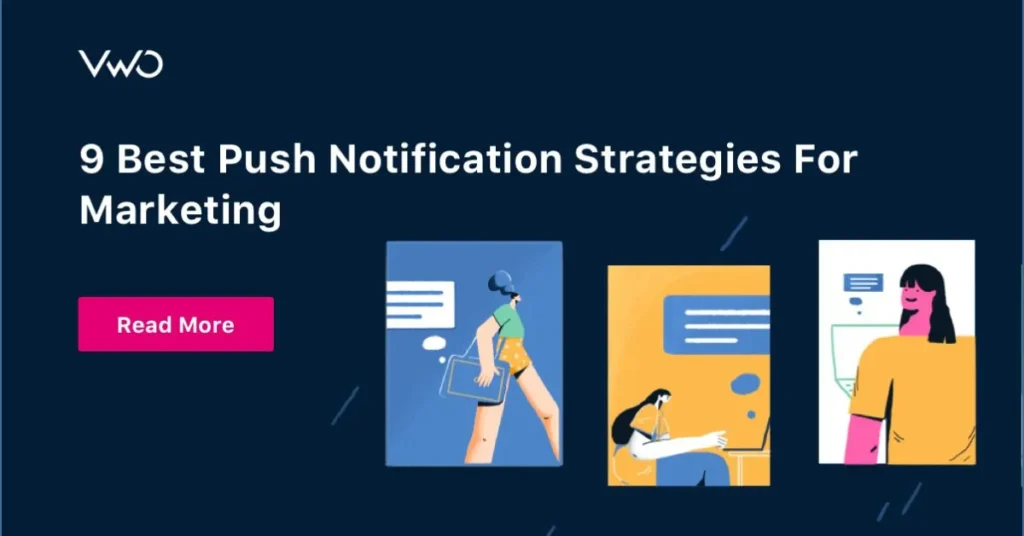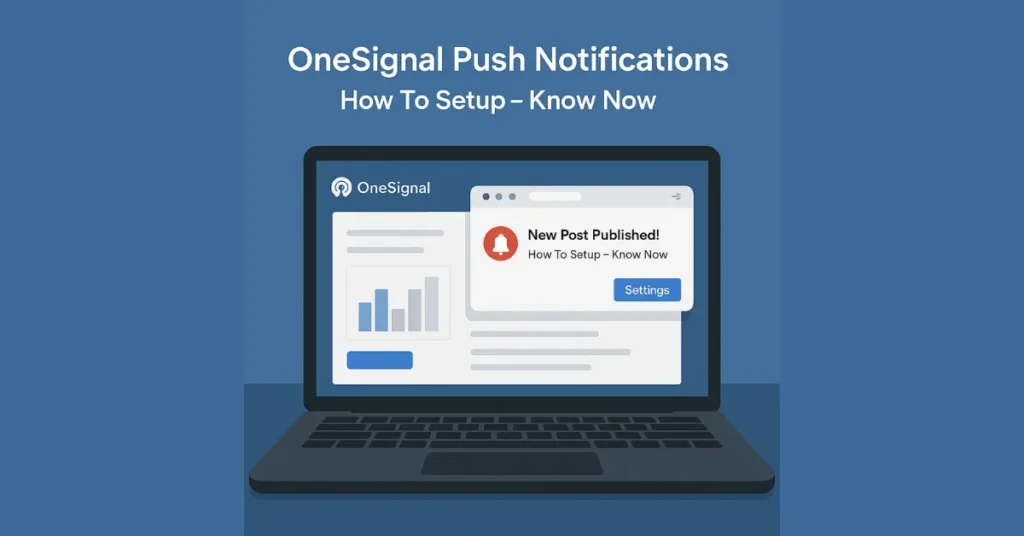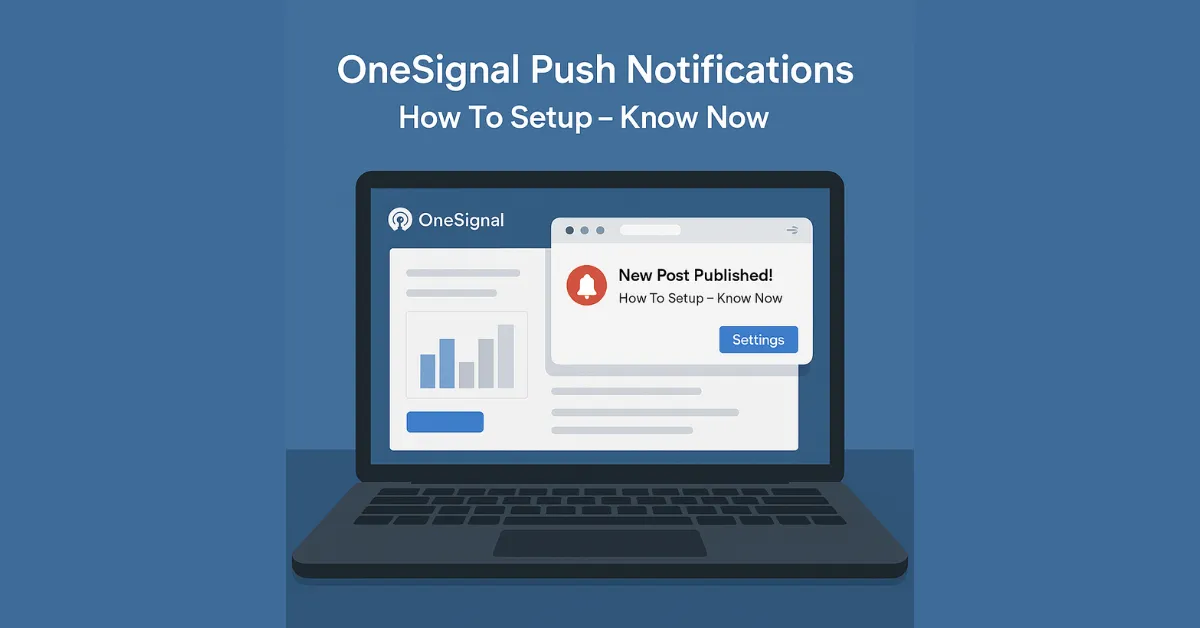Introduction
In today’s fast-paced digital landscape, capturing your audience’s attention is more challenging than ever. That’s where OneSignal Push Notifications come in—offering a direct, real-time way to engage users and drive traffic. Whether you’re a blogger, marketer, or e-commerce entrepreneur, OneSignal provides a powerful, user-friendly platform to deliver timely updates, boost retention, and increase conversions.
In this guide, you’ll learn how to set up push notifications with OneSignal, explore best practices, and discover advanced strategies to grow your subscriber base and monetize your content. Let’s dive into the world of smart engagement!

Table of Contents
Why OneSignal Push Notifications Are a Game-Changer for Engagement
Push notifications with OneSignal allow you to communicate instantly with your audience. With OneSignal, you can:
- Send real-time alerts for new posts, offers, or updates
- Reach users across web, Android, and iOS
- Segment audiences for personalized messaging
- Enjoy higher opt-in and click-through rates than email
🔗 Learn more about push notification strategies from VWO.
🛠️ Step-by-Step Guide to Integrating OneSignal Push Notifications
1. Create a OneSignal Account
Visit OneSignal.com and sign up. Choose your platform (Web Push, Mobile App, etc.).
2. Install the OneSignal Plugin (WordPress Users)
Go to WordPress → Plugins → Add New → Search “OneSignal Push Notifications” → Install & activate.
3. Configure Your Settings
Enter your App ID and API Key. Customize opt-in prompts and notification styles.
4. Test Your Setup
Subscribe from a test browser. Publish a post and confirm delivery.
🔗 External linking best practices from Moz.
💡 Best Practices for Using OneSignal Push Notifications Effectively
- Send notifications during peak user hours
- Keep messages short and actionable
- Use segmentation for targeted delivery
- Avoid spamming users with too many alerts
🔗 Explore external linking strategies for SEO success.
⚠️ Common Mistakes to Avoid When Using Push Notifications with OneSignal
- Using generic messages without personalization
- Forgetting to include a clear call to action
- Ignoring analytics and performance data
- Not optimizing for mobile users
🔗 Understand the risks of external links

📈 Advanced Strategies to Maximize OneSignal Push Notifications
🔄 Automation & Triggers
Set up alerts for cart abandonment, new posts, or user milestones.
📊 A/B Testing
Test headlines, icons, and timing to improve engagement.
🌍 Geo-Targeting
Send location-specific alerts for regional offers or updates.
🔗 Integrations
Connect OneSignal with Zapier, Firebase, or your CRM for seamless workflows.
🔗 25 safe backlink types to boost your blog’s SEO.
📚 Use Cases for Bloggers, Marketers, and E-Commerce Sites-OneSignal Push Notifications
Push notifications aren’t just for tech giants—they’re a versatile tool for:
📝 Bloggers
- Alert readers to new posts or updates
- Promote e-books or lead magnets
- Share curated content or roundups
🛍️ E-Commerce Sites
- Notify users of flash sales or restocks
- Send abandoned cart reminders
- Promote seasonal offers or bundles
📢 Digital Marketers
- Drive traffic to landing pages
- Promote webinars or events
- Deliver personalized content based on user behavior
📊 How to Grow Your Subscriber Base with Push Notifications
To build a loyal audience:
- Use clear opt-in prompts: Explain the value of subscribing
- Offer incentives: Exclusive content, early access, or discounts
- Place prompts strategically: Homepage, blog posts, exit intent
- Test and refine: Use analytics to improve conversion rates
🔗 OneSignal’s guide to increasing subscribers
💰 Monetizing Push Notifications: Smart Strategies
Push notifications can directly support your income goals:
- Promote affiliate products: Send alerts for deals or reviews
- Drive traffic to monetized content: Blog posts with ads or sponsored links
- Launch digital products: Notify users of new e-books, courses, or templates
- Offer consulting or services: Use segmentation to target high-value leads
🔗 Affiliate marketing with push notifications
Thanks for your patience, Dinesh! Here’s how to enhance your blog post with a powerful FAQ section and a featured snippet strategy—both designed to improve SEO, user experience, and your chances of ranking in Google’s top results.
✅ Featured Snippet Strategy
To optimize for a featured snippet (Google’s “Position 0”), follow these best practices:
📌 Format for Featured Snippets
- Use a clear subheading like:
What are push notifications with OneSignal? - Follow it with a concise definition (40–60 words): Push notifications with OneSignal are real-time alerts sent to users’ browsers or devices, allowing website owners to engage visitors instantly. OneSignal’s platform supports segmentation, automation, and cross-device delivery, making it ideal for bloggers, marketers, and e-commerce sites.
📌 Placement
- Put this definition early in the post, ideally within the first 300 words.
- Use proper heading tags (
H2for the question,Pfor the answer).
❓ FAQ Section (Add at the End of Your Blog Post)
Use this format in WordPress with H3 for questions and P for answers. You can also use the Details block or Ultimate Blocks plugin for collapsible toggles.
Frequently Asked Questions (FAQs)
What is OneSignal used for?
OneSignal is a push notification service that helps websites and apps send real-time alerts to users across devices and platforms.
Is OneSignal free to use?
Yes, OneSignal offers a free plan with essential features. Paid plans include advanced targeting, automation, and analytics.
Do push notifications improve engagement?
Absolutely. Push notifications can increase return visits, click-through rates, and conversions by delivering timely, personalized messages.
Can I use OneSignal with WordPress?
Yes. OneSignal provides an official WordPress plugin that makes integration simple and fast.
How do I grow my push notification subscriber list?
Use clear opt-in prompts, offer incentives like exclusive content, and place subscription options strategically across your site.
🧭 Final Thoughts on OneSignal Push Notifications
Implementing push notifications with OneSignal is a smart move for bloggers, marketers, and business owners. It’s simple to set up, highly effective, and helps you stay connected with your audience in real time.
Disclaimer
The information provided in this blog post is for educational and informational purposes only. It does not constitute financial, investment, legal, or professional advice. Readers are encouraged to consult with a qualified financial advisor or relevant professional before making any decisions based on the content.
For additional insights and resources on finance, AI, and digital transformation, please visit MultiAI World.
While every effort has been made to ensure accuracy, the author and publisher make no guarantees regarding the completeness or reliability of the information. Use of this content is at your own discretion and risk.
Dr. Dinesh Sharma is an award-winning CFO and AI strategist with over two decades of experience in financial leadership, digital transformation, and business optimization. As the founder of multiple niche platforms—including WorldVirtualCFO.com—he empowers professionals and organizations with strategic insights, system structuring, and innovative tools for sustainable growth. His blogs and e-books blend precision with vision, making complex financial and technological concepts accessible and actionable.


1 thought on “Best OneSignal Push Notifications 01: How To Fix Now”